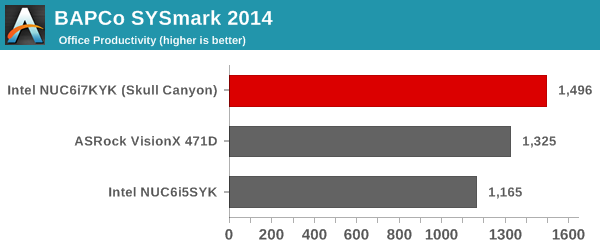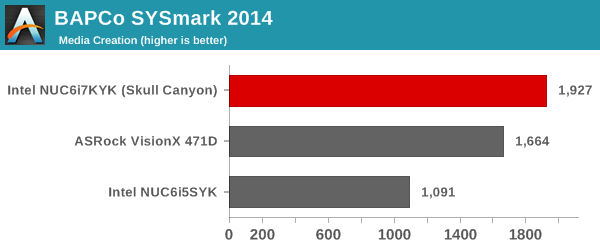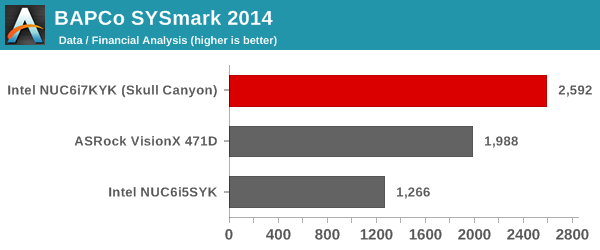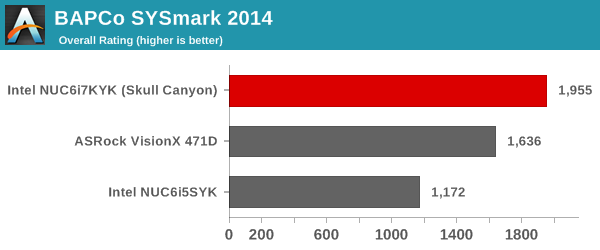The Intel Skull Canyon NUC6i7KYK mini-PC Review
by Ganesh T S on May 23, 2016 8:00 AM ESTPerformance Metrics - I
The Intel NUC6i7KYK (Skull Canyon) was evaluated using our standard test suite for low power desktops / industrial PCs. Not all benchmarks were processed on all the machines due to updates in our testing procedures. Therefore, the list of PCs in each graph might not be the same. In the first section, we will be looking at SYSmark 2014, as well as some of the Futuremark benchmarks.
BAPCo SYSmark 2014
BAPCo's SYSmark 2014 is an application-based benchmark that uses real-world applications to replay usage patterns of business users in the areas of office productivity, media creation and data/financial analysis. Scores are meant to be compared against a reference desktop (HP ProDesk 600 G1 with a Core i3-4130, 4GB RAM and a 500GB hard drive) that scores 1000 in each of the scenarios. A score of, say, 2000, would imply that the system under test is twice as fast as the reference system.




We started using SYSmark 2014 quite recently, which is the main reason for the absence of many of the comparison systems in the above graphs. In any case, the most interesting of the compared lot when it comes to CPU-intensive benchmarks like SYSmark 2014 is the ASRock VisionX 471D, equipped with a Core i7-4712MQ processor. We can see that the Core i7-6770HQ-based Skull Canyon NUC6i7KYK is miles ahead of the other two systems when it comes to office / business workloads. Readers interested in comparing the SYSmark 2014 scores for systems based on other CPUs can peruse the Bench results here.
Futuremark PCMark 8
PCMark 8 provides various usage scenarios (home, creative and work) and offers ways to benchmark both baseline (CPU-only) as well as OpenCL accelerated (CPU + GPU) performance. We benchmarked select PCs for the OpenCL accelerated performance in all three usage scenarios. These scores are heavily influenced by the CPU in the system. As expected, the Core i7-6770HQ enables the NUC6i7KYK to easily come out on top in the charts.



Miscellaneous Futuremark Benchmarks

The graphics benchmarks present a different story, though. In these, the NUC6i7KYK does perform well enough to come in the top half. However, in scenarios which are not CPU-bound, the systems equipped with discrete GPUs easily turn out to be better than Skull Canyon.




3D Rendering - CINEBENCH R15
CINEBENCH R15 is a standard benchmark for 3D rendering. It provides three benchmark modes - OpenGL, single threaded and multi-threaded. Evaluation of select PCs in all three modes provided us the following results.



In the single-threaded case, the Core i7-4770R (a 65W TDP CPU which can turbo up to 3.9 GHz) performs slightly better than the Core i7-6770HQ. However, the latter wins out in the multi-threaded cases. In the OpenGL case, the GIGABYTE system with the discrete GPU wins out, showing that a combination of CPU power as well as GPU is needed to perform well in this benchmark.










133 Comments
View All Comments
fanofanand - Monday, May 23, 2016 - link
You rebutted your own statement. Casual gamers don't buy $1k mini-PC's. Testing this at super low resolutions can only serve one purpose, which is to provide the appearance of acceptable performance.ganeshts - Monday, May 23, 2016 - link
The point with mini-PC reviews with a gaming focus is that they are spread far apart - we may be lucky to have 3 or 4 in a year.So, it boils down to what we think is more relevant to the reader - a set of benchmark numbers that have to be presented standalone, or a set of benchmark numbers which can be compared apples to apples against some similar previous-generation systems (because, that is what we have the numbers for). We think the latter makes more sense, and that is the reason we are having these 'legacy resolutions' in the gaming benchmarks.
fanofanand - Monday, May 23, 2016 - link
I completely understand why you need to present the information, I just don't think this really meets the "Skulltrail brand" expectations. Skulltrail was always an enthusiast platform designed by enthusiasts. This product looks like it fell victim to marketing requiring a certain thickness of chassis. This product waters down the skulltrail branding, though I guess skulltrail really isn't even relevant anymore. I just don't understand who this is designed for I guess.FMinus - Sunday, August 7, 2016 - link
this really isn't a low budget part, they can get similar or better performance in an ATX form factor for around ~$100 to 200 less.zepi - Monday, May 23, 2016 - link
I'd love to see a ~90W TDP version of this with CPU cores getting about 30W and GPU having 60 or so allocated for it. Even 65W TDP part would be a definite improvement for gaming as CPU / GPU clocks could stay considerably higher during loading of both parts of the chip.With proper cooling it could actually compete decently with low-end discrete graphic laptops. Now it is clear that TDP is limiting it badly.
The question is: How is the perf/w compared to for example A9x GPU parts or Maxwells? Somehow I'm not terribly impressed by Intel's GPU's. Especially considering that they've had their hugely superior manufacturing technology which should help...
Osamede - Monday, May 23, 2016 - link
Power consumption measured with a 1080p display. Is this the real use case?ganeshts - Monday, May 23, 2016 - link
Why not? Not everyone has migrated to 4K yet. I am a first-world tech reviewer, and the max. res monitor that I have is only 2560x1440 :)jhoff80 - Monday, May 23, 2016 - link
Out of curiosity, will there also be an Anandtech review of the new Core M Compute Sticks as well?jaydee - Monday, May 23, 2016 - link
Isn't is kinda a no-brainer to make this thing a little big bigger (with a little better cooling), to avoid throttling? Wouldn't just an inch taller help immensely?ShieTar - Monday, May 23, 2016 - link
Sure, but at ~55mm height it is beginning to look similar in size to a 70 mm high Mini-ITX case, which you can use to build yourself a system with similar compute power, for less than half the system cost.So it really needs to be very flat and very compact to qualify as a niche-product. Asking twice the price for just a 20% difference in some aspect is usually very hard to sell.